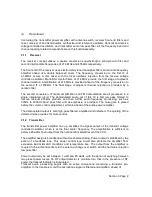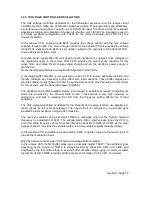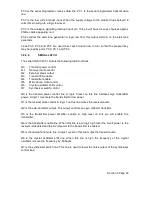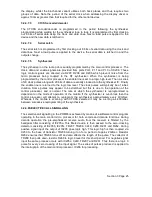
that 25 watts are available at the antenna socket. Broadband impedance matching circuits are
used between all stages with extensive use of printed microstrip.
The output power is stabilized by a power control feedback loop. The power detector consists
of a PI-section equivalent quarter-wave transmission line using L432, C594 and C597. The
detector is realized by D438 and C593. The do voltage is fed back to the inverting input of a
comparator circuit using OP AMP IC405. This voltage is compared to the reference voltage at
the non-inverting input which is set by the potentiometer R581. The comparator output voltage
provides a control bias current to transistor TR417. The action of this control loop is to adjust
the gain of TR417 to maintain a constant transmitter output power.
In the event of a mismatch load at the antenna socket, a standing wave will occur which
causes a higher potential to appear at one end of the quarter-wave transmission section. This
will cause a higher detected feedback voltage for the same transmitter power setting. The
comparator will correct for this error and the result is a reduction in the output power. For most
load mismatch conditions therefore, the transmitter is protected.
The PTC resistor R579 senses the operating temperature of the transmitter. In the event of a
temperature rise above 100 deg C the PTC resistance will increase. This will cause a
reduction of the control loop reference voltage and will thereby reduce the transmitter output
power, providing a further measure of protection.
A second potentiometer R578, is used to reduce the reference voltage when low power
operation is selected.
The output from the power amplifier is coupled to the antenna socket via a solid state antenna
changeover circuit and harmonic filter.
In the receive mode D439, D440 and D441 are all reverse biased. The antenna signal is
coupled through to the receiver input. The reverse bias on D440 and D441 in the receive
mode ensures a minimum loading on the receiver input by the diodes.
In the transmit mode, +9V is applied to R596 which biasses D439 on, and couples the output
power to the antenna socket. The bias current for D439 flows into D440 and D441 via a PI-
section equivalent quarter-wave transmission line. Transistor TR428 is also biassed on in
transmit mode and provides the ground return for diodes D440 and D441. Diodes D440 and
D441 are biassed on and form a short circuit across the receiver input to achieve isolation
from the transmitter. This short circuit is transformed to an effective open circuit by the action
of the quarter-wave transmission line PI-section, and therefore does not load the transmitter
output.
A harmonic rejection low pass filter is placed between the antenna changeover circuit and the
antenna socket.
At the output of the antenna changeover circuit, diode D442 which is loosely capacitively
coupled to the signal path, rectifies a small amount of the output power. This do voltage is
used to bias transistor TR424 on and provides the microprocessor with a signal to indicate
transmitter operation.
Section 3 Page 10
















































